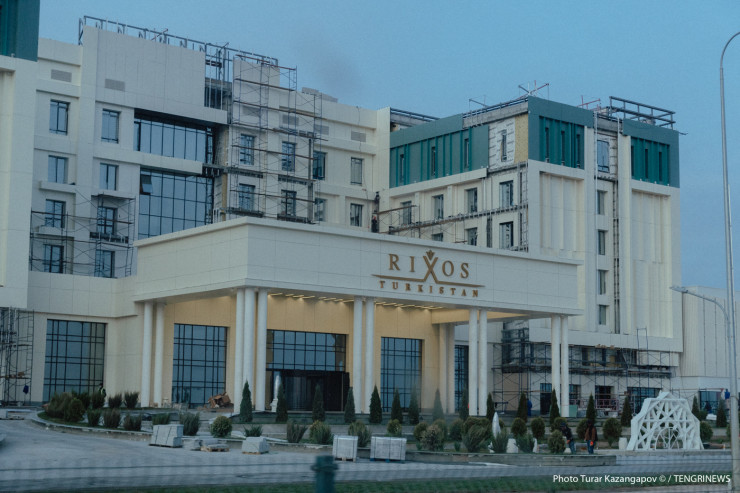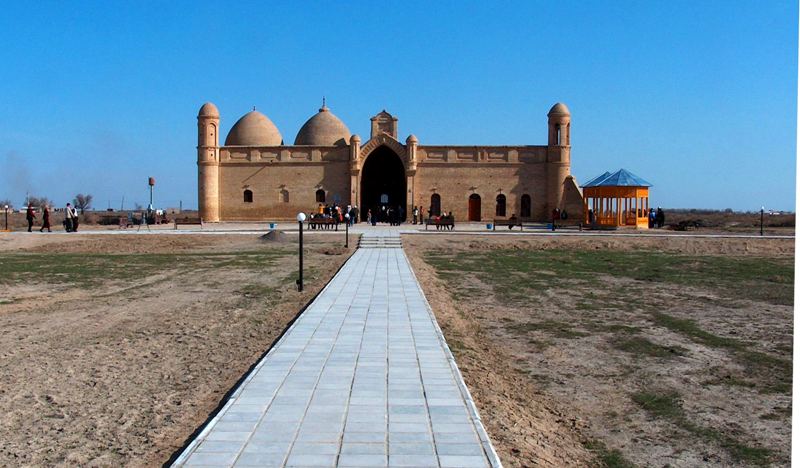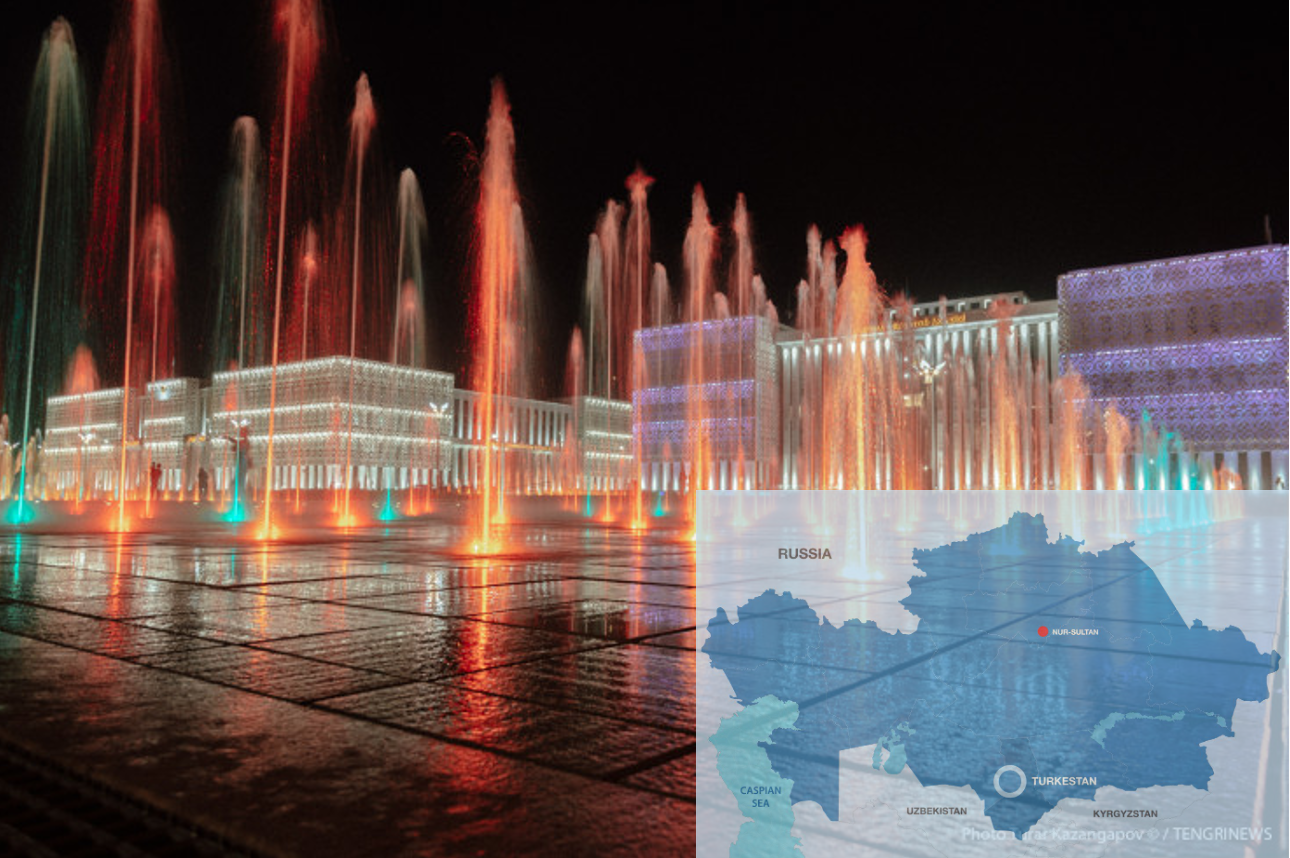NUR-SULTAN – Coronavirus may have disrupted certain plans, but certainly not the large scale construction taking place in Turkestan city, the center of the Turkestan Region, as it has recently unveiled a new sports arena, a brand new Rixos hotel, and a new congress center. Kazakhstan’s First President Nursultan Nazarbayev visited the new venues as part of his working visit to the region.
“Large scale construction in Turkestan is a boost to economic growth in the entire region. 450 billion tenge (US$1.05 billion) worth of direct investments was attracted to build 163 objects in the city. It also facilitated the growth of small and medium businesses. In the past year, the number of small and medium businesses increased by 20 percent reaching 11,000,” said Nazarbayev.
Nazarbayev visited the Turkestan Arena designed for 7,000 people, and the Uly Dala Eli center that has nine halls displaying milestones in Kazakh history since the Kazakh khanate with innovative story-telling tools.

New Turkestan Arena. Photo credit: Turar Kazangapov/Tengrinews
Tourism opportunities, which officials deem to be enormous in the city, could be unlocked with a brand new Rixos Khadisha Turkestan hotel with 120 rooms and spacious surroundings. The Hampton By Hilton hotel is also under construction in the city.

Photo credit: Turar Kazangapov/Tengrinews
During his visit, Nazarbayev was also briefed on plans for the construction of the Caravansaray multifunctional tourism complex that will include an indoor market, oriental bazaar, food and entertainment areas, and ethno hotels. The investments in the project totaled 83 billion tenge (US$193.5 million).
Located approximately 832 kilometers from Almaty and 166 kilometers from Shymkent, Turkestan is a great destination to immerse oneself in the authentic and vibrant culture of medieval Central Asia with all of its beautiful architectural complexes, noisy bazaars, and vast steppes.
Turkestan has been receiving greater attention from the government after then-President Nursultan Nazarbayev signed a decree in June 2018 making Turkestan the regional center of the newly renamed Turkestan Region, previously named South Kazakhstan. Nazarbayev repeatedly spoke of Turkestan as the political and spiritual center of the ancient Kazakh Khanate and the entire Turkic speaking world.
The region, which is home to nearly two million people, and located near the Syr Darya River boasts more than 1,500 years of rich history and numerous cultural and sacred sites that have been preserved to this day.
Spiritual Centre
During his visit, Nazarbayev stressed the city’s role as one of the major spiritual centers of the Turkic world which may facilitate Central Asian integration in the future.
In the 16th century, Kazakh khans (rulers) chose Turkestan as the capital of the Kazakh Khanate, leveraging on the city’s significant symbolic meaning in the region. It has since then served as a spiritual center attracting pilgrims from across the region.
For many of them, their main destination is the mausoleum of Khoja Ahmed Yassawi which dates back to the 15th and 16th centuries. Built in the late 14th century by the decree of Timur (Tamerlane), once a powerful ruler of Central Asia, the mausoleum is considered a masterpiece of medieval architecture. Prominent Kazakh leaders such as Abulkhair Khan, Abylai Khan and Yessim Khan, as well as Kazakh judge Kazbek-bi, one of the three key judges of the Kazakh Khanate, are buried inside the mausoleum. Timur died before the mausoleum was completed and it has remained in its original state since then. In 2004, it was included on the United Nations Educational, Scientific and Cultural Organisation (UNESCO) world cultural heritage list.

Khoja Ahmed Yassawi mausoleum
Muslim pilgrims throughout Central Asia come to commemorate Yassawi, an influential Turkic Muslim religious scholar and mystic who founded the Yassawiya order of Sufis.
The mausoleum dome and botanical garden nearby the mausoleum have been renovated.
Another major sacred place is the Arystan Bab mausoleum, devoted to Yassawi’s teacher, which many pilgrims believe should be visited before Yassawi’s mausoleum as a tribute to the scholar’s tutor, and Aisha Bibi mausoleum, a beautiful complex dating to the 12th century and decorated with unique carved terracotta tiles that, unlike other ancient buildings, were not glued to the bricks.

Arystan Bab Mausoleum. Photo credit: silkadv.com.
Growth of businesses
As much as officials seek to preserve the historic legacy of the region, they also focus on the development of small and medium-sized businesses that may benefit from an untapped market that can drive the region’s economic growth.
The region has nine industrial zones that offer favorable conditions for businesses to set up and develop. In 2019, eight projects were commissioned, worth 4.3 billion tenge (US$10 million) and guaranteeing 460 jobs.
For investors, there is a special economic zone with a total area of nearly 4,000 hectares and the new Turkistan industrial zone, which has incorporated international best practices in the construction of ready-to-use sites for investors on preferential terms. Another measure to support investors is the Turkistan Invest regional agency that helps investors with all stages of project implementation.
In 2020, the Turkestan Region plans to implement 97 investment projects worth 397.7 billion tenge (US$927.3 million) creating nearly 5,500 jobs, including 14 projects with foreign capital amounting to 268.8 billion tenge (US$626.8 million).
Agriculture, the green economy, the chemical industry and the construction of social facilities are the priority areas.
“We could not have dreamt it not so long ago. We are doing what no one has been able to do in hundreds of years. The new status of the city will be a platform for integration,” said Nazarbayev.


